|
103. Melitaea cinxia (Linnaeus, 1758) / Glanville fritillary / Nymphalidae – Melitaeinae
NL: veldmelitea, veldparelmoervlinder / D: Gemeiner Scheckenfalter, Wegerich-Scheckefalter / F: damier du plantain, melitée du plantain
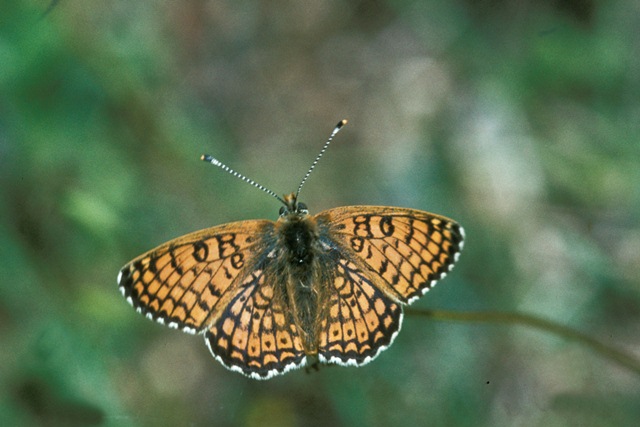 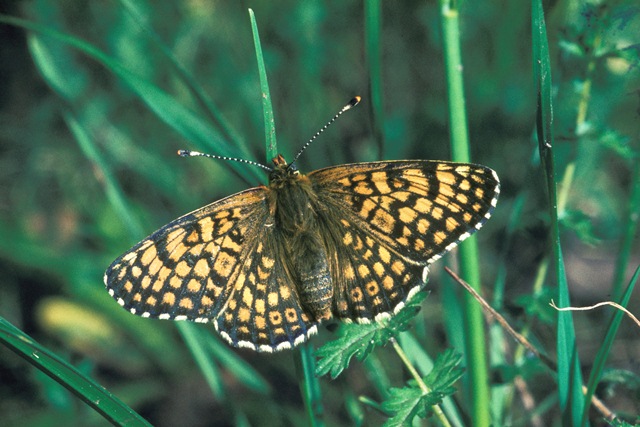 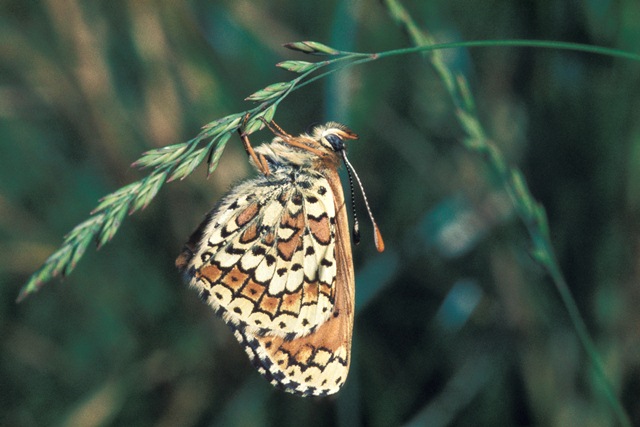 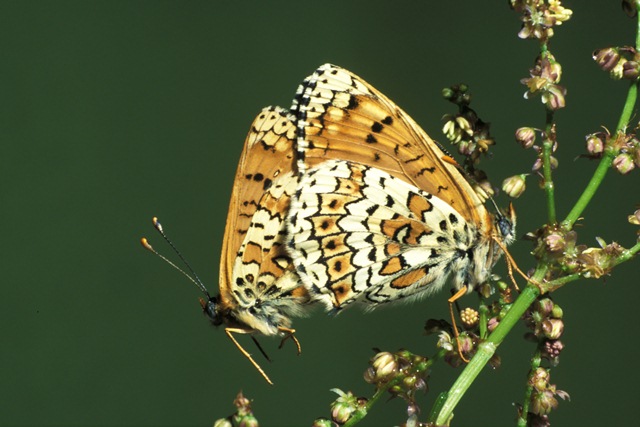
Photographs: Frits Bink ©.
Small or medium-sized, wing length 19 (16-21) mm. In the Benelux it occurs in Luxemburg and Wallonia and in the Netherlands on one site in grassland that is lightly grazed by cattle. Previously widely spread in the dunes of Netherlands.
Butterfly is on the wing from early-May until mid-June. The species is known from maritime and continental climates, amplitude 5 to 17. Required heat sum 700°d and maximum tolerated 2000°d, corresponding climate windows 24 and 38 weeks.
This species occurs in Europe widely spread in the coastal dunes with open landscape and short grass, on Gotland, Sweden, on the limestone pavement where Plantago grows and in England on the cliffs of the Isle of Wight where erosion and sea wind controls the vegetation. Elsewhere in Europe the species inhabits lightly grazed pastures.
Ecological characteristics
Behaviour over time
Overwintering: small larva in fourth instar, 5 mm in length, in a large, solid communal nest in litter layer.
Reproduction: oviposition starts after 4-5 days when the body contains 155 (124-186) eggs, potential production 1.8 times as much.
Larval feeding periods: in summer 44 (38-50) days in period end-June until end-August, next spring 58 (49-64) from early-March until mid-May.
Generations: one (in south Europe also a partial second one).
Spreading of risk: not observed.
Life cycle: egg 24 (20-28) days; larva 46 weeks (in the case of second brood 50 days); pupa 19 (12-29) days.
Life span of adult: rather long, 3 weeks.
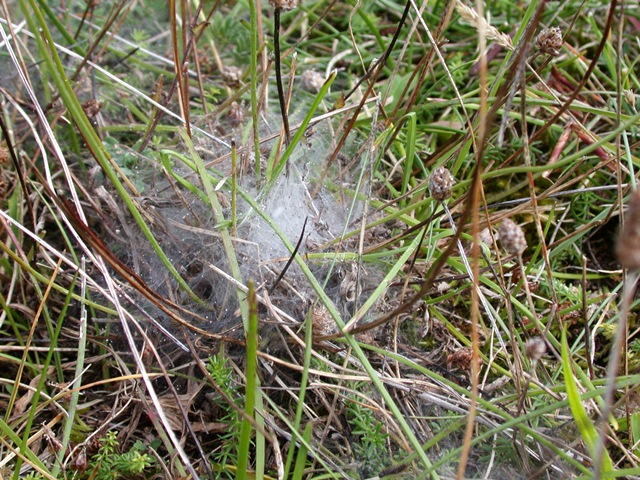 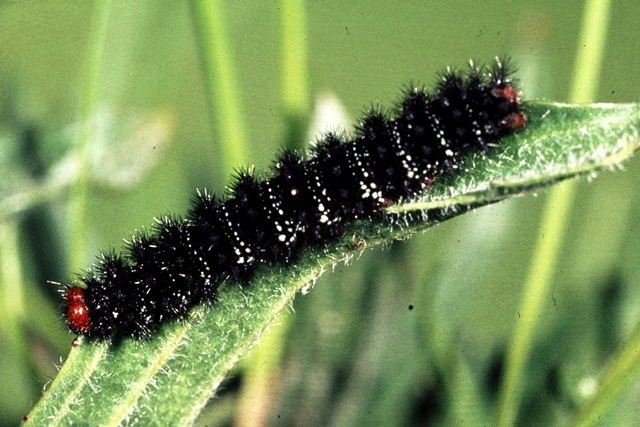
Photographs: Frits Bink ©.
Behaviour in space
From stay-at-home to migrant: stay-at-home, spatial requirement modest.
Finding a mate: male patrols.
Orientation in the landscape: mixture of short and tall grass, open landscape.
Oviposition: in batches of 60 up to 230 eggs on the underside of a leaf of the host-plant.
Defence
Threats from other organisms: larva is armoured with dense hairy bristles and are in general neglected by birds, except the cuckoo (Cuculus canorus).
Threats from the environment: a silky nest protects both pre- and post-diapause larvae.
Feeding habits
Adult: nectar of all kind of flowers in the grass vegetation.
Larva: are social in all stages, when grown up they move daily up to three metre from the nest to look for food and return in the evening. Larvae seven metre away from the nest appear to be solitary.
Larval foodplants
Plant species: Plantaginaceae, Plantago lanceolata, P. media, Veronica spicata.
Journal
Rearing experiments:
1. Based on specimens from Ismanstorp, Öland, Sweden:
8 July 1982: one pair in copula collected.
30 July: eggs hatched.
9 August: larvae in second instar.
19 September: larvae had constructed a solid nest, in diapause.
Overwintered outdoors.
13 March 1983: first larval activity, basked on their nest in the afternoon.
3 April: larvae had grown to about twice the size.
18 April: larvae in last instar in a group.
8 May: some larvae pupated in a group in a sheltered place.
15 May: last larva pupated.
5 June: majority already hatched.
16 June: last adult appeared, a female.
2. Based on specimen from Mare de Vauville, Normandy, France:
3 June 2000: two females collected in the dunes.
9 June: oviposited three batches: 223, 60 and 231 eggs each.
20 June: females dead.
2 July: larvae L1.
10 July: larvae L2.
22 July: larvae L3.
10 August: larvae in diapause.
Overwintered outdoors.
9 March 2001: signs of activity.
4 April: larvae in moult.
29 April: first larvae pupated.
3 May: 12 pupae, seven feeding larvae.
13 May: last larva pupated.
11 May: first adults appeared, males.
15 May: four females hatched.
19 May: two females oviposited batches 172, 188, 63.
22 May: last one, pupated 13 May, hatched. So spread in population only 11 days.
Continuation of F1:
16 June: first eggs hatched, egg stage lasted 28 days.
19 June: three-quarter of eggs hatched.
28 June: first larvae in moult.
6 July: larvae in third instar.
24 July: part of the larva now fourth instar with red heads.
25 July: larvae constructed a big nest.
28 July: larvae had stopped feeding, in diapause.
Overwintered outdoors.
15 March 2002: start of larval activity.
25 March: larvae split up in three smaller nests.
3 April: larvae 25 mm in length, moved up to 3 m from nest and returned in the afternoon.
8 April: great tit (Parus major) tried to eat a larva, killed it but did not eat it.
9 April: 13 larvae feeding, two 7 m and one 15m away from nest.
10 April: larvae ate Veronica spicata as soon as it was met.
26 April: last larva pupated.
15 May: first adult appeared, female.
3. Based on specimen from La Garde Freinet, Massif des Maures, France:
29 April 1997: female captured at a stony place near the edge of a wood bordering on a stream.
13 May: female oviposited.
A). A few larvae continued to feed rather than entering diapause.
28 June: first larva of the second brood fully grown.
5 July: larvae near to pupation.
22 July: first pupa of the second brood hatched, female.
B). Remaining larvae in diapause overwintered outdoors.
11 April 1998: larvae nearly fully grown.
18 April: larva fully grown.
Table 103-1. Results of dissections

Table 103-2. Collection and observation localities
D, Meetschow, 53° 02’ 32”N – 11° 23’ 32”E; 22June 1984.
D, Scherfede, 51° 32’ 27”N – 9° 01’ 09”E; 20 June 1984.
D, Staffelstein, 50° 05’ 32”N – 11° 01’ 25”E; 16 June 1985.
DK, Frøstrup, 57° 05´ 48”N – 8° 52´ 54”E; 13 June 2004.
DK, Bulbjerg, 57° 09’ 24”N – 9° 01’ 21”E; 13 June 2004.
F, Aurel, 400 m, 44° 43’N – 5° 16’E; 29 August 1984 (larvae).
F, la Garde Freinet, 236 m, 43° 17’ 58”N – 6° 28’ 22”E; 29 April 1997.
F, Normandy, Saint-Germain, 49° 13’ 13”N – 1° 37’ 36”W; 31 May 2000, 17 September 2005. (larvae).
F, Normandy, Vauville, 49° 37’ 36”N – 1° 50’ 43”W; 3 June 2000.
F, Normandy, Mare de Vauville, 49° 37’ 55”N – 1° 50’ 56”W; 3 June 2000.
F, Vosges, Katzenkoepfle, 565m, 48° 01’ 54”N – 7° 06’ 04”E; 4 September 1981 (larvae), 11 June 1984.
S, Gotland Buttle, 57° 25’ 09”N 18° 34’ 38”E; 17 July 1982, 25 June 2004, 6 July 2004.
S, Gotland, Folhammar, 57° 20’ 49”N – 18° 44’ 12”E; 19 June 2004.
S, Gotland, Kappelshamn, 57° 55’ 04”N – 18° 45’ 20”E; 30 June 2004.
S, Gotland, Lickershamn, 57° 50’ 17”N – 18° 34’ 54”E; 3 July 2004.
S, Gotland, Ljugarn, 57° 22’ 03”N – 18° 41’ 31”E; 21 June 2004, 24 June 2004.
S, Gotland, Östergarn, 57° 24’ 43”N – 18° 43’ 27“E; 15 July 2004.
S, Gotland, Russväter, 57° 23 29”N – 18° 43’ 36”E, 16 July 2004.
S, Öland, Ismantorp borg, 56° 44’ 44”N – 16° 38’ 33”E; 8 July 1982.
S, Öland, Noaks ark, 26 m, 56° 46’ 29”N – 16° 37’ 27”E; 9 July 1982.
S, Öland, Stenåsa, 56° 32’ 44”N – 16° 36’ 43”E; 7 July 1982.
Fig. 103-1. Melitaea cinxia, phenogram adapted from Fichefet et al. 2008: 239.
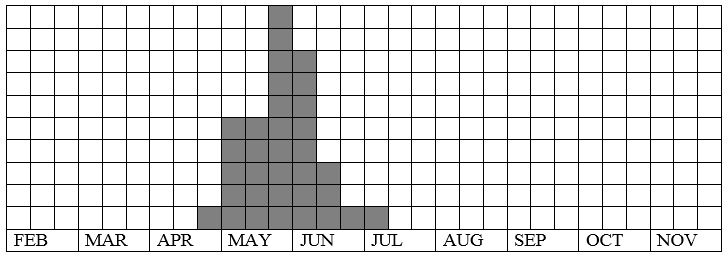
Fig. 103-2. Melitaea cinxia, habitat characteristics.
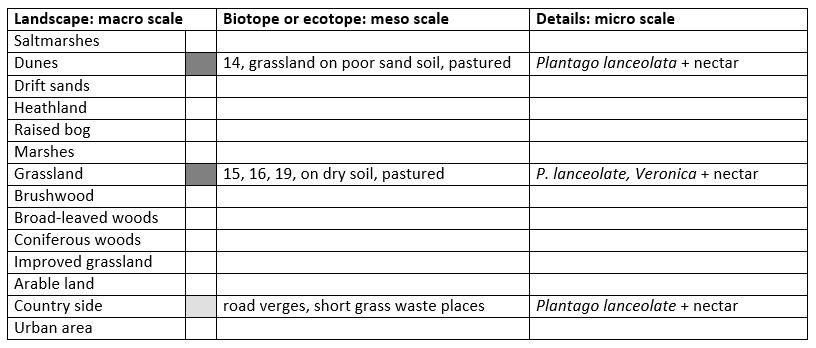
Fig. 103-3. Melitaea cinxia, climate matrix, heat-sums 700 - 2000°d.
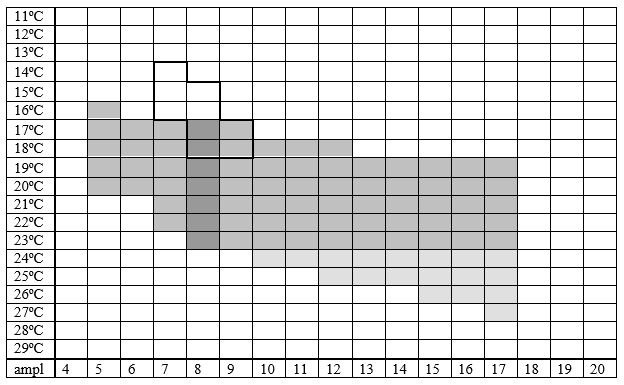
|











